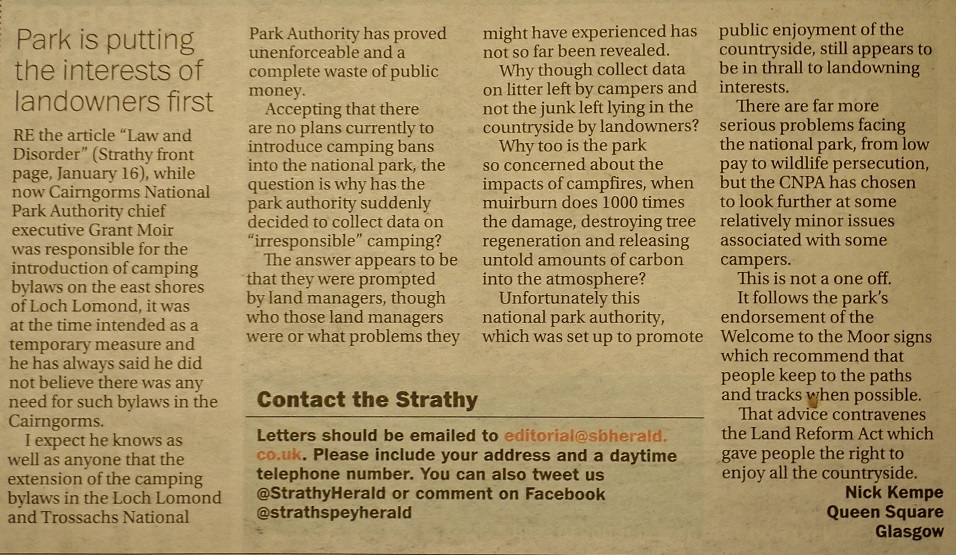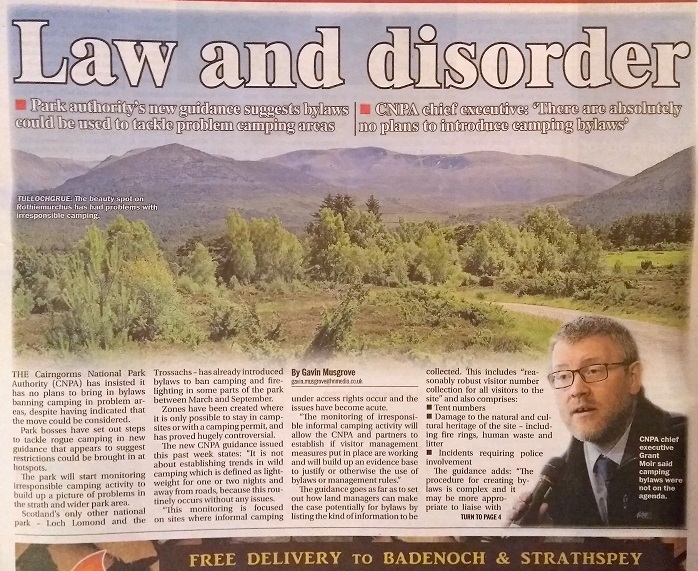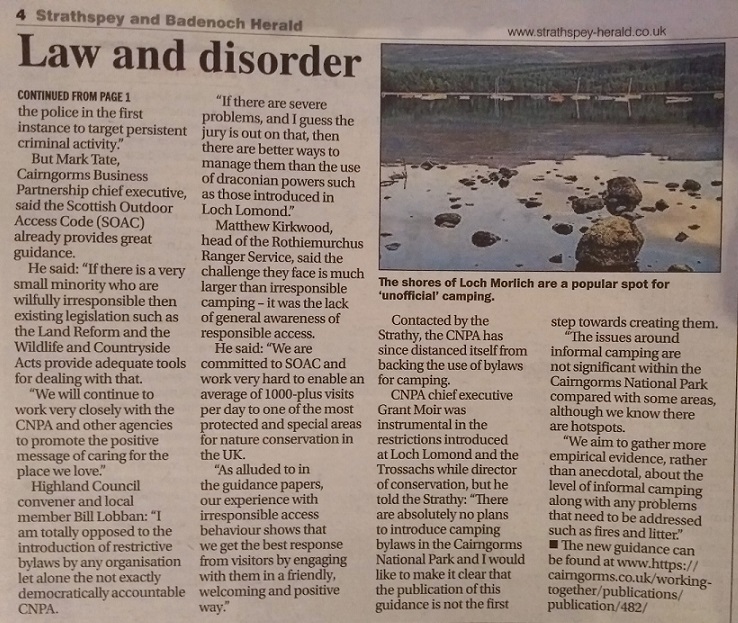
I was pleased to get this letter into the Badenoch and Strathspey Herald on Thursday in response to their excellent coverage the week before about the potential for camping byelaws to be introduced into the Cairngorms National Park Authority.

While it was good to see Grant Moir, the CNPA Chief Executive (above) deny there were any plans to introduce camping byelaws at the present time, that isn’t the same as saying they are off the agenda. I have seen correspondence from CNPA access staff justifying the inclusion of camping byelaws in the revised guidance it has issued to landowners on the basis these powers exist and therefore it would be wrong NOT to mention them.
If that is the case, then why does the CNPA never include reference to its powers (never used) to create byelaws for conservation purposes in other guidance it puts out to landowners? Part of the answer is that the CNPA doesn’t put out guidance to land managers about how they should manage the land but only guidance about how they should manage visitors (see here). There is no reason, however, why other documents should not refer to the CNPA’s powers to make conservation byelaws (for example to stop raptor persecution, stop All Terrain Vehicles destroying peat bog, stop the muirburn which trashes so much of the National Park). The CNPA though has NEVER to the best of my knowledge done this. The message is they are prepared to consider using compulsory powers to control visitors but not the activities of irresponsible landowners. This is not a level playing field and, until it is, the CNPA deserve to be criticised and recreational interests need to remain vigilant.

It was therefore very good to see both the Chief Executive of the Cairngorms Business Partnership, Mark Tate, and Convener of Highland Council, Bill Lobban make a strong stand against camping byelaws and to criticise those in the Loch Lomond and Trossachs National Park Authority as draconian.
They could have added that the LLTNPA byelaw have been a waste of scarce public money. I was interested to read in the minutes of the “Your Park” Stakeholder Forum meeting in December (see here) – and it is a stepforward that the LLTNPA is now making this information public – that in response to an excellent question from James Fraser, of the Friends of Loch Lomond and Trossachs, the Park:
“confirmed that the report [to Scottish Ministers reviewing how the byelaws have operated for the last three years] will include financial information including the amount of revenue involved and ranger deployment costs but will not include a full cost/benefit analysis”
That tell’s you everything and I hope the Friends (of whom I am a “critical” member) now oppose the renewal fof the camping byelaws.
A cost benefit analysis would show that trying to police campers has not only failed for campervans but is far less effective and far more expensive than trying to put in place the basic infrastructure needed to support camping and campervanning. Until that cost benefit analysis is conducted we will see the proliferation of what are sometimes well intentioned but ill thought out measures to control camping and caravanning across Scotland on the Loch Lomond and Trossachs model (such as in Fife (see here) and the North Coast 500 (see here)). This is the wrong way to go and why the Loch Lomond and Trossachs byelaws need to be scrapped.
There is no smoke without fire and behind the Strathy news story a major problem is developing in Glen More and around Aviemore, the most popular visitor destination in the National Park. Formal campsites are becoming ever more expensive. The new Oakwood campsite by Aviemore, for example, charges a minimum of £12 for a small tent and £21 for a campervan per night low season (see here) and there are similar prices throughout Glen More.
Meantime as a result of increasing inequality its hard if not impossible for many people to get out and visit our National Park. Of these many can’t afford to stay in built accommodation and as a result camp, sleep in the backs of vans or hire a campervan for a week. High campsite prices – and costs in the UK are enormous compared to Europe (for £20 a night in the summer, ie the high season, I got free access to local transport and lifts in the Saas Taal in Switzerland) – then force many people into roadside camping and campervanning when if, like on the continent, there was an aire available with basic facilities, most would stay there.
Couple this with Forestry and Land Scotland’s attempted ban on overnight stays by its car parks along Glen More (see here) and there are suddenly very few places for people to stop off in the most popular glen in the National Park. This explains the great increase in the number of campervans now stopping at Coire na Ciste, its about the last place you can go. In bad weather, however, that is not an option so people pull off in other places along Glen More and suddenly the volume of people camping and campervanning informally becomes perceived as a problem.
This is the “problem” that the CNPA has now agreed with landowners to monitor but, instead of saying that the reason for doing this is to decide where best to create “aires” across the National Park, they refer to their powers to control campers by camping byelaws, i.e. by bans. Where campervans, which don’t come under access rights, fit into this is unclear. Instead of this approach, its time that the CNPA, along with Councils for areas like Fife and Highland, started to plan for what basic infrastructure is needed in their areas to support visitors otherwise they will simply repeat the shocking mistakes of the Loch Lomond and Trossachs National Park Authority.
I was up around Loch Morlich this weekend with my campervan. £18 to camp at an official site – with no electric hook up, but access to the toilet block – and this is low season. I noted many campervans simply wild camping. This is a popular area; formal camp site spaces are scarce and in the summer they book up well in advance. Often this is as a result of caravan bookings – unlike motorhomes and campervans you can’t easily wild camp in a caravan. The result is no option but to wild camp if you have a campervan and want to stop.
Of course no surprise that those who profit from this scarcity would prefer to limit wild camping.
Given that campervans are largely self-contained, if the authority wants to encourage access one obvious solution is to create more service points and wild camping (i.e. parking) for campervans. This encourages people to stay more than a day – and spend more money locally. Its all rather obvious – so why isn’t the authority actively supporting this sort of strategy?
And if you want to make the investment self-funding, just put a barrier up and create some French-style Aires – or get a company experienced in this sector, like campingcarpark.com, to do it all for you.
This is all further evidence that the ‘authorities’ (and I use that term in a general sense i.e. SG, NPs and local authorities (declaration – I work for one of the latter in a relatively senior role) simply too often don’t ‘get’ access and wild camping – seeing it as creating problems rather than a principled ‘right’.
The recent SG consultation on ‘Tourist taxes’ (or Transient Visitor Levy in the jargon) even managed to conflate the issues of sometimes excessive and problematic impacts of motorhomes etc with wild camping by asking a single question about the desirability of extending the potential new tax to both groups. Thankfully, my council saw this as being contrary to the spirit of the Land Reform Act and the SOAC in respect of wild camping, as well as being entirely impractical (how would such a levy ever be indenified as chargeable and/or actually collected?) and responded accordingly. But even asking the question in such a way shows how this issue is just not understood and/or recognised in too many ‘corridors of power’
Is it actually necessary to survey campervan users or campers ? Ask which they would rather : (A) Park /pitch on a level well drained site. (B) use somewhere with access to a shower and toilet block. (C) exist on a potholed narrow layby with passing traffic. (D) overnight o some rough muddy slope where the likelihood of farm animals or passers by is great? The responses to these questions, and the £ value they place on each choice, should never startle. The one thing local communities should never do is set out to alienate those who might wish to remain overnight near their pubs, restaurants, shops and other facilities. I live in a remote beautiful place in a crofting area. Nearby, a back filled space was created a decade ago for a new house. This has never been built on yet. The 1/4 acre area has a sea view and is attractive to campervanners. Each week in season a number do use use it. The vast majority ‘leave as found’, and cause no trouble. We have spoken with many lovely people over the years. We find no trace of their short stay on the space. One hours work could fence it off, but why be so inhospitable? Surely a barricade here would simply shift any van further down the road – and this district would fail to retain and encourage overnight visitors. As nearest resident I consider my own interests do include taking a moment to clean up any rubbish that is carelessly dropped. I feel that if I failed to do this, as I wander past, the willingness of passers-by to respect the place they had enjoyed would diminish. ( The plot actually is not my ground- what surrounds it is. ) Why do many people across Scotland still think that tidying up their home area must be someone else’s responsibility? (An attempt to answer follows) Everyone…campers, walkers and Caravan owners included… must aim to leave people and things better than they found them. “Ownership” of the access problem through outdoor Education is the only long term remedy for Scotland. Once any level of officious fee is extracted – staff encountered: seen to monitor challenge and restrict -the “ownership” of the resultant mess will switch to the ‘persecuto’. It is human nature to resent any authority that, without consent, claims it has control. When Official resentment of visitors to Scotland replaces tolerance at an individual level, this ‘interference’ will always prove counter productive.
I wonder if more people are travelling to the cairngorms due to the regimes draconian bylaws in the trossachs
One of the best places I found for camping with a tent was Applecross They had a metor petrol machine not the no petrol after 9 oclock sign the toilets had a water tap on the out side for campers ,large bins near the beaches The community had no problem with wild campers infact the pub and Applecross was buzzing and wee were happy to spend in Applecross I would also point out the toilets were open unlike firkin on Loch Lomond that shut at 7 o’clock which is a disgrace to turisom and the biggest problem with human toileting in the wet wipes/babe wipes they don’t break down and are a eye sore. As Steph said it’s because of Draconian Scotland is not turisom friendly right now .